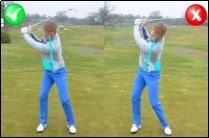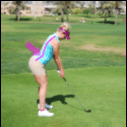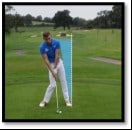3 Golf Swing Faults that Contribute to Low Back Pain

With some restrictions for the stay at home order being lifted, many of us are out golfing right now (some for the very first time). Many players experience low back pain during or after a round of golf, making the game a little less fun. Low back pain is the biggest complaint among golfers. Research shows at least 28% of players experience this pain. There are 3 main swing faults that contribute to developing lower back symptoms.

1. Reverse spine angle – raising up in the back-swing causing the torso to point away from the target instead of toward it. This makes it very difficult to start the downswing in the proper sequence, due to the lower body being placed in a position that usually limits its ability to initiate the downswing. This swing characteristic is also one of the main reasons for low back pain in golfers. When the lower body can’t start the downswing or (has a limited ability to initiate the movement) the upper body tends to dominate the swing. This will eventually create path problems and limit power output. Reverse spine angle puts excessive tension on the lower back due to inhibition of the abdominal musculature during the back-swing, and excessive compressive loads placed on the right side of the spine at impact. This can be due to several reasons including:
- Lack of flexibility in the lats and spine causing difficulty in separating the upper body from the lower body
- Lack of trail hip internal rotation causing the body to translate lateral to try and get more motion
- Weakness in the gluteal muscles and core causing the inability to stabilize through the hip during the back-swing
- S-posture at set up causing too much arch in the lower back at the top back swing causing a lateral bend of the spine in the wrong direction.

S-posture – is a setup position created by the player having too much arch in their low back by sticking out the tail bone too much. This excessive curve in the low back inhibits the core muscles from firing correctly during the swing and places abnormal stresses on the low back. The deactivation of core muscles can cause loss of posture and a reverse spine angle during the back-swing. In turn, causes a downswing that is out of sequence. There are several reasons a player can have S-posture. Often times it’s due to a postural dysfunction that involves tight hip flexors (front of the hip), tight lower back muscles and weakness in the core and gluteal muscles.

Hanging back – refers to a lack of weight shift towards the target on the downswing. The player is usually still on their back foot at impact and often all the way until follow through. This not only causes physical stress, but results in loss of club head speed. During the downswing, it’s important to sequence the body correctly, but also of equal importance is transferring your weight to the lead leg and allowing your body to rotate around the lead hip versus keeping your weight on the trail leg. When the weight isn’t shifted correctly it causes excessive trunk flexion and right-side bending (for a right-handed golfer) at impact all the way through follow through. The right side of the back gets excessively torqued, sheared, compressed and all around irritated. It eventually will talk back to you in the words of PAIN! Several reasons this can happen are lack of lead hip mobility, poor lower body power and sequencing; and poor strength/stability through the lead hip causing the arms/upper body to be more dominant.
With the many possible physical limitations that can cause swing faults, it’s important to have your body ASSESSED. Hulst Jepsen Physical Therapy offers golf assessments that will help discover your particular limiting factor and reason for pain—or reason for lack of power and consistency. Our assessment will then give us a plan to improve the limitations. Some issues in the swing can be due to inexperience or habit, but many are due to the inability of your body to move correctly. It’s extremely beneficial to see a certified TPI medical professional to find out where your limitations are and help set up an exercise program specifically designed for you. This will help you understand how your limitations affect your swing. Whether you’re experiencing pain, stiffness or just lack of consistency and power Hulst Jepsen Physical Therapy can help you!
For golfers looking to improve their game beyond physical limitations, exploring the world of holistic health can be another powerful tool. Holistic health and Wellness, as described in this website, focuses on the interconnectedness of your physical, mental, and emotional well-being. By incorporating practices like yoga or meditation, you can improve your focus and concentration during your swing. Additionally, mindfulness techniques can help manage on-course anxiety and frustration, leading to a more enjoyable and consistent game. There are numerous online and in-person courses available that cater specifically to holistic health for athletes. These programs can equip you with the tools to optimize your overall well-being, both on and off the course.
Interested in more information or in scheduling a Golf Physical Assessment? Give us a call at 616.827.3010 or email one of our certified TPI medical professionals, Robyn Smith at rsmith@hjphysicaltherapy.com.
